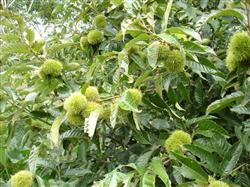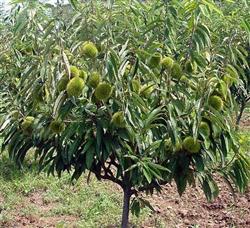How can chestnut trees be managed to produce a high yield?

How can chestnut trees be managed to produce a high yield? Please give guidance to chestnut trees can refer to the following methods for management: first, fertilizing spring pre-anthesis fertilizer can be applied 300 grams of urea and 200 grams of calcium 300 grams, and per square meter of borax 6 grams 7 grams. During the period of fruit bud expansion in July, the plant applied strong fruit fertilizer and three-element compound fertilizer 0.7-1kg. From June to October, 5 grams of borax solution and 5 grams of paclobutrazol were applied per square meter. Once every 30 days, 3 times and 4 times. After fruit harvest, overwintering fertilizer was applied again, 40 kg of pig, cattle manure or soil fertilizer, 0.7 kg of calcium magnesium phosphate fertilizer and 1.5 kg of calcium magnesium phosphate fertilizer. In addition, 0.2% borax solution, 0.3% urea and 0.2% potassium dihydrogen phosphate mixture were sprayed twice every 10 days to improve the fruit setting rate. The mixture of 0.3% urea, 0.2% potassium dihydrogen phosphate and mancozeb was sprayed every 20 days to promote the growth and development of branches, leaves and fruits. After fruit picking, 10 ppm 2mine4murd solution was sprayed once to promote flower bud differentiation and nutrient accumulation. Second, trim the chestnut and enjoy the light. The overgrowing elongated branches and dense thin and weak branches should be removed in time to make the trees ventilated and transparent, and the work of controlling and wiping them should be done well in spring to promote secondary shoots. The male inflorescences which are too dense and weak should be cut off as soon as possible, and the fruiting branches with female flowers can be truncated or coring at 3 ~ 4 nodes above the female inflorescence. Wangding chestnut trees which do not blossom for years or only have male flowers can use wire constriction to bind the main branches for 1 or 2 turns, or spiral ring cutting to promote the number of flowers and the formation of female flowers. The hanging of the iron wire was carried out from August to September and released before the tree sprouted in the following year. Ring cutting or engraving should be carried out from September to October, and the xylem should not be injured. 3. Castanea mollissima is a cross-pollinated fruit tree of the same plant. More than two pollinated varieties should be planted in the orchard to facilitate pollination. When the variety is single, it can be pollinated artificially to protect fruit, and in full bloom, male flowers are collected before 10:00 or after 3 pm on a rainless day. When there are many trees or tall trees, they can be pollinated by shaking in the crown with 3 or 4 times of starch in gauze bags. Once every 3 or 4 days, twice in a row. The ratio of leaf to fruit should be controlled at 20 ∶ 1 to 25 ∶ 1 when there are more fruits in Chinese chestnut. There are 1 or 2 buds on the medium and short fruit branches, 2 or 3 buds on the flower and fruit branches, the middle fruit with strong growth, the apex fruit on the short fruit branch, and the small, deformed, overdense, disease, insect and empty bract fruit. Click to get more chestnut planting techniques click to get more fruit planting techniques
- Prev

What should I pay attention to when planting chestnut trees?
What should I pay attention to when planting chestnut trees? Please give advice to plant chestnut trees should pay attention to the following points: first, young tree management ① planted chestnut seedlings should be timely watering, after regular watering according to soil moisture. ② weeds breed rapidly. In order to reduce weeds competing with trees for water and fertilizer, weeds in tree plates should be removed in time.
- Next

How to plant and trim Chinese chestnut?
How to plant and trim Chinese chestnut? Please introduce chestnut planting and pruning can refer to the following methods: chestnut cultivation techniques 1. Select the suitable plot: according to the characteristics of Chinese chestnut, the soil pH of the plot must be about 4: 7, the plot should be in the middle and lower part of the mountain, the light light loam is the best. two。 Planting density.
Related
- Moge, come on! The staff of the peasant association in the producing area of cantaloupe were frightened when the crowd gathered.
- Causes and Solutions of low Fruit setting rate of Apple
- Symptoms and control measures of passion fruit virus disease
- Fruit growing lesson: how do apple orchards keep high yields?
- Can you build orchards in the mountains? What are the pros and cons?
- How to manage the coloring period of Crisson grape?
- This paper introduces the processing technology of two kinds of fig products.
- How much is a month for retired teachers in rural areas by 2020?
- How can strawberry planting increase sugar content? We should pay attention to management in many aspects.
- What are the cultivation techniques on how to improve the yield of golden fruit?

